Automatic Pattern Recognition of Tectonic Lineaments in Seafloor Morphology to Contribute in the Structural Analysis of Potentially Hydrocarbon-Rich Areas
Abstract
1. Introduction
- (a)
- marine geomorphology/geomorphometrics and further structural studies;
- (b)
- the accurate tracing of tectonic lineaments on the seafloor in large marine areas;
- (c)
- the detection of morphostructures on the seafloor related to shallow evaporite movement known as halokinesis.
2. Materials and Methods
2.1. Enhancement of the Seafloor Texture
2.2. Multiple Filtering
2.3. Pixel Labeling
- Tl is given by the mean value of Im values that reveal a value lower than Med.
- Th is given by the mean value of Im values that reveal a value higher than Med.
- If Im(p) ≥ Th and Im(p) > mv(p), p is classified to C1, as its value is very high compared with the image (Im(p) ≥ Th) and with its neighbourhood (Im(p) > mv(p)).
- Else, if Im(p) ≥ Th or (Im(p) > Tl and Im(p) > mv(p)), p is classified to C2. This is true if the pixel value is high compared with the image, but it is not high enough compared with its neighbourhood, or reversely.
- Otherwise, p is classified to C3.
3. Results
3.1. Automatically Calculated Bathymetric Skeleton
- The length of lineaments (short, medium, long);
- The direction of lineaments;
- The spatial distribution of the lineaments (sparse, medium, dense).
- Sub-region A: Located in the Southern Cretan offshore (Ptolemy and Pliny Trenches including Gavdos high), characterized by medium to long in length and medium to sparse distributed lineaments generally trending NE–SW, NW–SE, and E–W, which present high detection strength (Figure 3a,b).
- Sub-region B: Located in the Southern Cretan offshore (Strabo Trench and the region west of Gavdos high) characterized by short to medium in length and medium to dense distributed lineaments trending to all directions (Figure 3a,b). The lineaments in the southeastern part of sub-region B present high detection strength, while those in the southwestern part of sub-region B present low detection strength (Figure 3a).
- Sub-region C: Located in the Southern Cretan offshore (Mediterranean Ridge) characterized by medium to long in length and medium to sparse distributed lineaments. Lineaments, close to the limit with sub-regions B and C, present similar orientation with this limit (Figure 3a,b). In addition, the lineaments near to the limit with sub-regions B and C present high detection strength (Figure 3a). The lineaments away from the limit with sub-regions B and C are generally short in length, medium to sparse distributed, and show no prevailing orientation (Figure 3a,b).
- Sub-region A’: Located on and west of the Eratosthenes Seamount characterized by (a) the presence of strong detected E–W trending, medium to long in length, and medium to sparse distributed lineaments on the Eratosthenes Seamount; and (b) very few, weak detected lineaments west of the Eratosthenes Seamount (Figure 4a,b).
- Sub-region B’: Located southwest of the Eratosthenes Seamount characterized by (a) strong detected, NE–SW trending lineaments intersected by a group of NW–SE trending lineaments, both long in length and sparse distributed; and (b) medium to weak detected lineaments with no prevailing orientation that are short in length and sparse to medium distributed (Figure 4a,b).
- Sub-region C’: Located east and southeast of the Eratosthenes Seamount characterized by generally weak detected, short in length and medium to sparse distributed lineaments that generally trend E–W to NW–SE (Figure 4a,b).
3.2. Comparison with Ground Truth Data
4. Discussion
4.1. Seafloor Deformation due to Halokinesis and Tectonism
- Well-distinguished groups of lineaments trending to specific directions (Figure 5a and Figure 6) characterize the bathymetric pattern related to areas mostly affected by tectonism. The detection strength of the lineaments for these groups is generally high (red and yellow colors in Figure 3a and Figure 6);
- Morphostructures on the seafloor related to shallow salt movement (halokinesis) are recognized based on flow like characteristics such as (a) irregular seafloor topography, (b) downslope ridges and troughs, (c) presence of flow lobes (d) along-slope ridges and areas of rough topography, and (e) steplike morphology. In addition, areas with seafloor related to salt movements may be limited by distinctive, linear or curvilinear, continuous, long, and strongly detected lineaments that probably correspond to large-scale geological faults (Figure 5b, area indicated by green line).
4.2. The Contribution of Multiple Filtering and Skeletonization in Marine Geology and Geophysics
- prior to marine mapping at the stage where already available digitized data are reprocessed and evaluated, aiming to accurately specify the research targets and reduce the time and financial cost of the entire marine research;
- in digital bathymetric data acquired through remote sensing techniques or marine surveying.
- Multiple filtering is scale and orientation invariant [78].
- Automatic identification does not require any ground truth data or training process as the popular deep learning (neural networks)-based methods [85], which cannot be applied in most of the cases, owing to unavailable or very limited ground truth data.
- The detection strength, the length, the direction of lineaments, as well as their spatial distribution are robust criteria for their sorting and further geological interpretation.
5. Conclusions
- The skeleton, provided by the application of the present scheme, preserves the shape and symmetry of the original lineaments. In addition, the tracing of the lineaments is accurate, taking into account their location, direction, and spatial extend. Obviously, the accuracy of lineaments automatic extraction depends on DEM’s accuracy.
- Multiple filtering and skeletonization are independent in training process, so it works even in cases of limited ground truth data.
- Robust criteria, such as the strength of the detection, the length, the direction, the spatial distribution, and/or density of the lineaments, are valuable for the interpretation of the bathymetric patterns. Consequently, either seafloor morphology related with intense tectonic activity or evaporite movements with seafloor expression can be recognized and further interpreted to assist the structural analysis of potentially hydrocarbon-rich areas.
Author Contributions
Funding
Acknowledgments
Conflicts of Interest
References
- Micallef, A.; Krastel, S.; Savini, A. (Eds.) Introduction. In Submarine Geomorphology; Springer: Berlin, Germany, 2018; pp. 1–9. [Google Scholar]
- Lecours, V.; Dolan, M.F.J.; Micallef, A.; Lucieer, V.L. A review of marine geomorphometry, the quantitative study of the seafloor. Hydrol. Earth Syst. Sci. 2016, 20, 3207–3244. [Google Scholar] [CrossRef]
- Lucieer, V.L.; Lecours, V.; Dolan, M.F.J. Marine Geomorphometry; MDPI: Basel, Switzerland, 2019; pp. 1–402. [Google Scholar]
- Parsons, B.; Sclater, J.G. An analysis of the variation of ocean floor bathymetry and heat flow with age. J. Geophys. Res. 1977, 82, 803–827. [Google Scholar] [CrossRef]
- Wessel, P.; Chandler, M.T. The spatial and temporal distribution of marine geophysical surveys. Acta Geophys. 2011, 59, 55–71. [Google Scholar] [CrossRef]
- Kokinou, E.; Panagiotakis, C. Structural pattern recognition applied on bathymetric data from the Eratosthenes Seamount (Eastern Mediterranean, Levantine Basin). Geo-Mar. Lett. 2018, 38, 527–540. [Google Scholar] [CrossRef]
- Camerlenghi, A. Drivers of Seafloor Geomorphic Change. In Submarine Geomorphology; Micallef, A., Krastel, S., Savini, A., Eds.; Springer: Cham, Switzerland, 2018; pp. 135–159. [Google Scholar]
- Belenitskaya, G. Salt Systems of the Earth: Distribution, Tectonic and Kinematic History, Salt-Naphthids Interrelations, Discharge Foci, Recycling; Wiley Online Library: Hoboken, NJ, USA, 2018; pp. 1–693. [Google Scholar]
- Kweon, I.S.; Kanade, T. Extracting topographic terrain features from elevation maps. CVGIP Image Underst. 1994, 59, 171–182. [Google Scholar] [CrossRef]
- Miliaresis, G.C.; Argialas, D. Segmentation of physiographic features from the global digital elevation model/gtopo30. Comput. Geosci. 1999, 25, 715–728. [Google Scholar] [CrossRef]
- Dinesh, S. Extraction of mountains from digital elevation models using mathematical morphology. GIS Dev. Malays. 2006, 1, 16–19. [Google Scholar]
- Iwahashi, J.; Pike, R.J. Automated classifications of topography from dems by an unsupervised nested-means algorithm and a three-part geometric signature. Geomorphology 2007, 86, 409–440. [Google Scholar] [CrossRef]
- Booth, A.M.; Roering, J.J.; Perron, J.T. Automated landslide mapping using spectral analysis and high-resolution topographic data: Puget sound Lowlands, Washington, and Portland hills, Oregon. Geomorphology 2009, 109, 132–147. [Google Scholar] [CrossRef]
- Obu, J.; Podobnikar, T. Algorithm for karst depression recognition using digital terrain models. Geod. Vestn. 2013, 57, 260–270. [Google Scholar] [CrossRef]
- Euillades, L.D.; Grosse, P.; Euillades, P.A. Netvolc: An algorithm for automatic delimitation of volcano edifice boundaries using dems. Comput. Geosci. 2013, 56, 151–160. [Google Scholar] [CrossRef]
- Panagiotakis, C.; Kokinou, E. Linear Pattern Detection of Geological Faults via a Topology and Shape Optimization Method. IEEE J. Sel. Top. Appl. Earth Obs. Remote Sens. 2015, 8, 3–11. [Google Scholar] [CrossRef]
- Micheal, A.A.; Vani, K. Automatic mountain detection in lunar images using texture of dtm data. Comput. Geosci. 2015, 82, 130–138. [Google Scholar] [CrossRef]
- Panagiotakis, C.; Kokinou, E. Unsupervised Detection of Topographic Highs with Arbitrary Basal Shapes Based on Volume Evolution of Isocontours. Comput. Geosci. 2017, 102, 22–33. [Google Scholar] [CrossRef]
- Han, L.; Liu, Z.; Ning, Y.; Zhao, Z. Extraction and analysis of geological lineaments combining a DEM and remote sensing images from the northern Baoji loess area. Adv. Space Res. 2018, 62, 2480–2493. [Google Scholar] [CrossRef]
- Florinsky, I.V. Quantitative topographic method of fault morphology recognition. Geomorphology 1996, 16, 103–119. [Google Scholar] [CrossRef]
- Florinsky, I.V. Digital Terrain Analysis in Soil Science and Geology, 2nd ed.; Elsevier: Amsterdam, The Netherlands, 2016; pp. 1–486. [Google Scholar]
- Warren, J.K. Evaporites, a Geological Compendium, 2nd ed.; Springer: Berlin, Germany, 2016; pp. 1–1813. [Google Scholar]
- Hudec, M.R.; Jackson, M.P.A. Terra infirma: Understanding salt tectonics. Earth-Sci. Rev. 2007, 82, 1–28. [Google Scholar] [CrossRef]
- Hobbs, W.H. Lineaments of Atlantic Border region. Bull. Geol. Soc. Am. 1904, 15, 483–506. [Google Scholar] [CrossRef]
- O’Leary, D.W.; Friedman, J.D.; Pohn, H.A. Lineament, linear, lineation: Some proposed new standards for old terms. Bull. Geol. Soc. Am. 1976, 87, 1463–1469. [Google Scholar] [CrossRef]
- Makarov, V.I. Lineaments: Problems and trends of studies by remote sensing techniques. Izv. Vuz. Geol. Razv. 1981, 4, 109–115. (In Russian) [Google Scholar]
- Florinsky, I.V. Global Lineaments: Application of Digital Terrain Modelling. In Advances in Digital Terrain Analysis. Lecture Notes in Geoinformation and Cartography; Zhou, Q., Lees, B., Tang, G., Eds.; Springer: Berlin/Heidelberg, Germany, 2008; pp. 365–382. [Google Scholar]
- Berthou, P. EMODNET-the European marine observation and data network. Eur. Sci. Found. Mar. Board 2008, 10. [Google Scholar]
- Benkhelil, J.; Mart, Y.; Mascle, J.; Woodside, J.M.; The Prismed II Scientific Party. Recent morphostructural evolution of the Eratosthenes Seamount: Initial Results of the Prismed II Cruise. European Union of Geosciences/EUG 10, Strasbourg (France). J. Conf. Abs. 1999, 4, 756, Terra Abstracts 11. [Google Scholar]
- CIESM/Ifremer Medimap Group; Loubrieu, B.; Mascle., J. Morpho-bathymetry of the Mediterranean Sea. CIESM: Monte Carlo, Monaco, 2008. [Google Scholar]
- Huebscher, C. RV MARIA S. MERIAN, Cruise Report MSM14/L3 Eratosthenes Seamount/Eastern Mediterranean Sea 2010; DFG Senatskommission für Ozeanographie: Bremen, Germany, 2012. [Google Scholar]
- U.S. Department of Commerce, National Oceanic and Atmospheric Administration, National Geophysical Data Center. 2-Minute Gridded Global Relief Data (ETOPO2v2). 2006. Available online: http://www.ngdc.noaa.gov/mgg/fliers/06mgg01.html (accessed on 12 May 2020).
- Kokinou, E.; Panagiotakis, C.; Sarris, A. Application of Skeletonization on Geophysical Images. In Proceedings of the XIX Congress of the Carpathian Balkan Geological Association, Thessaloniki, Grecce, 23–26 September 2010; Volume 99, pp. 338–343. [Google Scholar]
- Panagiotakis, C.; Kokinou, E.; Sarris, A. Curvilinear Structure Enhancement and Detection in Geophysical Images. IEEE Trans. Geosci. Remote Sens. 2011, 49, 2040–2048. [Google Scholar] [CrossRef]
- Alves, T.M.; Kokinou, E.; Zodiatis, G.; Lardner, R.; Panagiotakis, C.; Radhakrishnan, H. Modelling of oil spills in confined maritime basins: The case for early response in the Eastern Mediterranean Sea. Environ. Pollut. 2015, 206, 390–399. [Google Scholar] [CrossRef] [PubMed]
- Alves, T.; Kokinou, E.; Zodiatis, G.; Lardner, R. Hindcast, GIS and susceptibility modelling to assist oil spill clean-up and mitigation on the southern coast of Cyprus (Eastern Mediterranean). Deep-Sea Res. Part II 2016, 133, 159–175. [Google Scholar] [CrossRef]
- Alves, T.M.; Kokinou, E.; Zodiatis, G.; Radhakrishnan, H.; Panagiotakis, C.; Lardner, R. Multidisciplinary oil spill modeling to protect coastal communities and the environment of the Eastern Mediterranean Sea. Sci. Rep. 2016, 6, 36882. [Google Scholar] [CrossRef]
- Kokinou, E. Geomorphologic features of the marine environment in Eastern Mediterranean using a modern processing approach. In Proceedings of the IAMG 2015, the 17th Annual Conference of the International Association for Mathematical Geosciences, Freiberg, Germany, 5–13 September 2015; Schaeben, H., Tolosana Delgado, R., van den Boogaart, G.K., van den Boogaart, R., Eds.; IAMG: Freiberg, Germany, 2015; pp. 436–445. [Google Scholar]
- Andronikidis, N.; Kokinou, E.; Vafidis, A.; Kamberis, E.; Manoutsoglou, E. Deformation patterns in the southwestern part of the Mediterranean Ridge (South Matapan Trench, Western Greece). Mar. Geophys. Res. 2018, 39, 475–490. [Google Scholar] [CrossRef]
- Toulia, E.; Kokinou, E.; Panagiotakis, C. The contribution of pattern recognition techniques in geomorphology and geology: The case study of Tinos Island (Cyclades, Aegean, Greece). Eur. J. Remote Sens. 2018, 51, 88–99. [Google Scholar] [CrossRef]
- Canny, J. A computational approach to edge detection. IEEE Trans. Pattern Anal. Mach. Intell. 1986, 8, 679–698. [Google Scholar] [CrossRef]
- Kermad, C.D.; Chehdi, K. Automatic image segmentation system through iterative edge-region co-operation. Image Vis. Comput. 2002, 8, 541–555. [Google Scholar] [CrossRef][Green Version]
- Kokinou, E.; Alves, T.M.; Kamberis, E. Structural decoupling on a convergent forearc setting (Southern Crete, Eastern Mediterranean). Geol. Soc. Am. Bull. 2012, 124, 1352–1364. [Google Scholar] [CrossRef]
- IGME (Institute of Mineral and Geological Exploration). Seismotectonic Map of Greece. Scale 1:500000; IGME: Athens, Greece, 1989. [Google Scholar]
- Manta, K.; Rousakis, G.; Anastasakis, G.; Lykousis, V.; Sakellariou, D.; Panagiotopoulos, I.P. Sediment transport mechanisms from the slopes and canyons to the deep basins south of Crete Island (southeast Mediterranean). Geo-Mar. Lett. 2019, 39, 295–312. [Google Scholar] [CrossRef]
- Mascle, J.; Sardou, O.; Loncke, L.; Migeon, S.; Camera, L.; Gaullier, V. Morphostructure of the Egyptian continental margin: Insights from swath bathymetry surveys. Mar. Geophys. Res. 2006, 27, 49–59. [Google Scholar] [CrossRef]
- Schattner, U. What triggered the early-to-mid Pleistocene tectonic transition across the entire eastern Mediterranean? Earth Planet. Sci. Lett. 2010, 289, 539–548. [Google Scholar] [CrossRef]
- Feldens, P.; Mitchell, N. Salt flows in the Central Red Sea. In The Red Sea: The Formation, Morphology, Oceanography and Environment of a Young Ocean Basin; Rasul, N., Stewart, I., Eds.; Springer: Berlin/Heidelberg, Germany, 2015; pp. 205–218. [Google Scholar]
- Trusheim, F. Über Halokinese und ihre Bedeutung für die strukturelle Entwicklung Norddcutschlands. Z. Deutch. Geol. Ges. 1957, 198, 111–151. [Google Scholar]
- Trusheim, F. Mechanism of salt migration in northern Germany. AAPG Bull. 1960, 44, 1519–1540. [Google Scholar]
- Kokinou, E.; Kamberis, E.; Vafidis, A.; Monopolis, D.; Ananiadis, G.; Zelilidis, A. Deep seismic reflection data from offshore Western Greece: A new crustal model for the Ionian Sea. J. Pet. Geol. 2005, 28, 81–98. [Google Scholar] [CrossRef]
- Hersey, J.B. Sedimentary basins of the Mediterranean Sea. In Submarine Geology and Geophysics, Proceedings of the 17th Symposium of the Colston Research Society, London, UK, 5–9 April 1965; Whitard, W.F., Bradshaw, W., Eds.; Butterworths: London, UK, 1965; pp. 75–91. [Google Scholar]
- Hsu, K.J.; Cita, M.B. The origin of the Mediterranean Evaporite. In Initial Reports of the Deep Sea Drilling Project; U.S. Government Printing Office: Washington, DC, USA, 1973; Volume 13, pp. 1203–1231. [Google Scholar]
- Monopolis, D.; Bruneton, A. Ionian Sea (Western Greece): Its structural outline deduced from drilling and geophysical data. Tectonophysics 1982, 83, 227–242. [Google Scholar] [CrossRef]
- Brooks, M.; Ferentinos, G. Tectonics and Sedimentation in the Gulf of Corinth and Zakynthos and Kefallinia channels, western Greece. Tectonophysics 1984, 101, 25–54. [Google Scholar] [CrossRef]
- Kopf, A.; Vidal, N.; Klaeschen, D.; von Huene, R.; Krasheninnikov, V.A. Multi-channel seismic profiles across Eratosthenes Seamount and the Florence Rise reflecting the incipient collision between Africa and Eurasia near the island of Cyprus, Eastern Mediterranean. In Geological Framework of the Levant, Volume II: The Levantine Basin and Israel; Hall, J.K., Krasheninnikov, V.A., Hirsch, F., Benjamini, C., Flexer, A., Eds.; Historical Productions-Hall: Jerusalem, Israel, 2005; pp. 57–72. [Google Scholar]
- Neev, D.; Almagor, G.; Arad, V.; Ginzburg, A.; Hall, J.K. The geology of the southeastern Mediterranean Sea. Geol. Surv. Isr. Bull. 1976, 68, 1051. [Google Scholar]
- Ben-Avraham, Z. The structure and tectonic setting of the Levant continental margin, Eastern Mediterranean. Tectonophysics 1978, 46, 313–331. [Google Scholar] [CrossRef]
- Garfunkel, Z.; Arad, V.; Almagor, G. The Palmahim disturbance and its regional setting. Geol. Surv. Isr. Bull. 1979, 72, 56. [Google Scholar]
- Mart, Y.; Ben-Gai, Y. Some depositional patterns at continental margin of southeaster Mediterranean Sea. AAPG Bull. 1982, 66, 460–470. [Google Scholar]
- Almagor, G.; Hall, J.K. Morphology of the continental margin off north-central Israel. Isr. J. Earth Sci. 1983, 32, 75–82. [Google Scholar]
- Garfunkel, Z. Large-scale submarine rotational slumps and growth faults in the eastern Mediterranean. Mar. Geol. 1984, 55, 304–324. [Google Scholar] [CrossRef]
- Frey-Martinez, J.; Cartwright, J.A.; Hall, B. 3D seismic interpretation of slump complexes: Examples from the continental margin of Israel. Basin Res. 2005, 17, 83–108. [Google Scholar] [CrossRef]
- Gradmann, S.; Huebscher, C.; Ben-Avraham, Z.; Gajewski, D.; Netzband, G. Salt tectonics off northern Israel. Mar. Pet. Geol. 2005, 22, 597–611. [Google Scholar] [CrossRef]
- Bertoni, C.; Cartwright, J.A. Controls on the basinwide architecture of late Miocene (Messinian) evaporites on the Levant margin (Eastern Mediterranean). Sediment. Geol. 2006, 188, 93–114. [Google Scholar] [CrossRef]
- Bertoni, C.; Cartwright, J.A. Major erosion at the end of the Messinian Salinity Crisis: Evidence from the Levant Basin, Eastern Mediterranean. Basin Res. 2007, 19, 1–18. [Google Scholar] [CrossRef]
- Loncke, L.; Gaullier, V.; Mascle, J.; Vendeville, B.; Camera, L. The Nile deep-sea fan: An example of interacting sedimentation, salt tectonics, and inherited subsalt paleotopographic features. Mar. Pet. Geol. 2006, 23, 297–315. [Google Scholar] [CrossRef]
- Netzeband, G.; Huebscher, C.; Gajewski, D. The structural evolution of the Messinian evaporites in the Levantine Basin. Mar. Geol. 2006, 230, 249–273. [Google Scholar] [CrossRef]
- Mart, Y.; Ryan, W. The Levant slumps and the Phoenician structures: Collapse features along the continental margin of the southeastern Mediterranean Sea. Mar. Geophys. Res. 2007, 28, 297–307. [Google Scholar] [CrossRef]
- Cartwright, J.A.; Jackson, M.P.A. Initiation of gravitational collapse of an evaporate basin margin: The Messinian saline giant, Levant Basin, eastern Mediterranean. Geol. Soc. Am. Bull. 2008, 120, 399–413. [Google Scholar] [CrossRef]
- Clark, I.R.; Cartwright, J.A. Interactions between submarine channel systems and deformation in deepwater fold belts: Examples from the Levant Basin, Eastern Mediterranean Sea. Mar. Pet. Geol. 2009, 26, 1465–1482. [Google Scholar] [CrossRef]
- Gvirtzman, Z.; Reshef, M.; Buch-Leviatan, O.; Ben-Avraham, Z. Intense salt deformation in the Levant Basin in themiddle of the Messinian Salinity Crisis. Earth Planet. Sci. Lett. 2013, 379, 108–119. [Google Scholar] [CrossRef]
- Reiche, S.; Huebscher, C. The Hecataeus Rise, easternmost Mediterranean: A structural record of Miocene-Quaternary convergence and incipient continent-continent-collision at the African-Anatolian plate boundary. Mar. Pet. Geol. 2015, 67, 368–388. [Google Scholar] [CrossRef]
- Symeou, V.; Homberg, C.; Nader, F.H.; Darnault, R.; Lecomte, J.C.; Papadimitriou, N. Longitudinal and Temporal Evolution of the Tectonic Style Along the Cyprus Arc System, Assessed Through 2-D Reflection Seismic Interpretation. Tectonics 2018, 37, 30–47. [Google Scholar] [CrossRef]
- Rouchy, J.M.; Caruso, A. The Messinian salinity crisis in the Mediterranean basin: A reassessment of the data and an integrated scenario. Sediment. Geol. 2006, 188, 35–67. [Google Scholar] [CrossRef]
- Manzi, V.; Gennari, R.; Lugli, S.; Roveri, M.; Scafetta, N.; Schreiber, B.C. High frequency cyclicity in the Mediterranean Messinian evaporites: Evidence for solar–lunar climate forcing. J. Sediment. Res. 2012, 82, 991–1005. [Google Scholar] [CrossRef]
- Roveri, M.; Flecker, R.; Krijgsman, W.; Lofi, J.; Lugli, S.; Manzi, V.; Sierro, F.J.; Bertini, A.; Camerlenghi, A.; De Lange, G.; et al. The Messinian Salinity Crisis: Past and future of a great challenge for marine sciences. Mar. Geol. 2014, 352, 25–58. [Google Scholar] [CrossRef]
- Soliman, A.; Han, L. Effects of vertical accuracy of digital elevation model (DEM) data on automatic lineaments extraction from shaded DEM. Adv. Space Res. 2019, 64, 603–622. [Google Scholar] [CrossRef]
- Xu, J.; Wen, X.; Zhang, H.; Luo, D.; Li, J.; Xu, L.; Yu, M. Automatic extraction of lineaments based on wavelet edge detection and aided tracking by hillshade. Adv. Space Res. 2020, 65, 506–517. [Google Scholar] [CrossRef]
- Gournia, C.; Fakiris, E.; Geraga, M.; Williams, D.P.; Papatheodorou, G. Automatic Detection of Trawl-Marks in Sidescan Sonar Images through Spatial Domain Filtering, Employing Haar-Like Features and Morphological Operations. Geosciences 2019, 9, 214. [Google Scholar] [CrossRef]
- Parker, J.R. Algorithms for Image Processing and Computer Vision, 2nd ed.; Wiley Publishing: Indianapolis, IN, USA, 2010; ISBN 0470643854. [Google Scholar]
- Bounneche, M.D.; Boubchir, L.; Bouridane, A.; Nekhoul, B.; Ali-Chérif, A. Multi-spectral palmprint recognition based on oriented multiscale log-Gabor filters. Neurocomputing 2016, 205, 274–286. [Google Scholar] [CrossRef]
- Panagiotakis, C.; Argyros, A. Region-based Fitting of Overlapping Ellipses and its Application to Cells Segmentation. Image Vis. Comput. 2020, 93, 103810. [Google Scholar] [CrossRef]
- Panagiotakis, C.; Tziritas, G. Snake terrestrial locomotion synthesis in 3D virtual environments. Vis. Comput. 2006, 22, 86–98. [Google Scholar] [CrossRef]
- Zhu, X.X.; Tuia, D.; Mou, L.; Xia, G.S.; Zhang, L.; Xu, F.; Fraundorfer, F. Deep learning in remote sensing: A comprehensive review and list of resources. IEEE Geosci. Remote Sens. Mag. 2017, 5, 8–36. [Google Scholar] [CrossRef]
- Liu, H.; Wu, Z.H.; Zhang, X.; Hsu, D.F. A skeleton pruning algorithm based on information fusion. Pattern Recognit. Lett. 2013, 34, 1138–1145. [Google Scholar] [CrossRef]
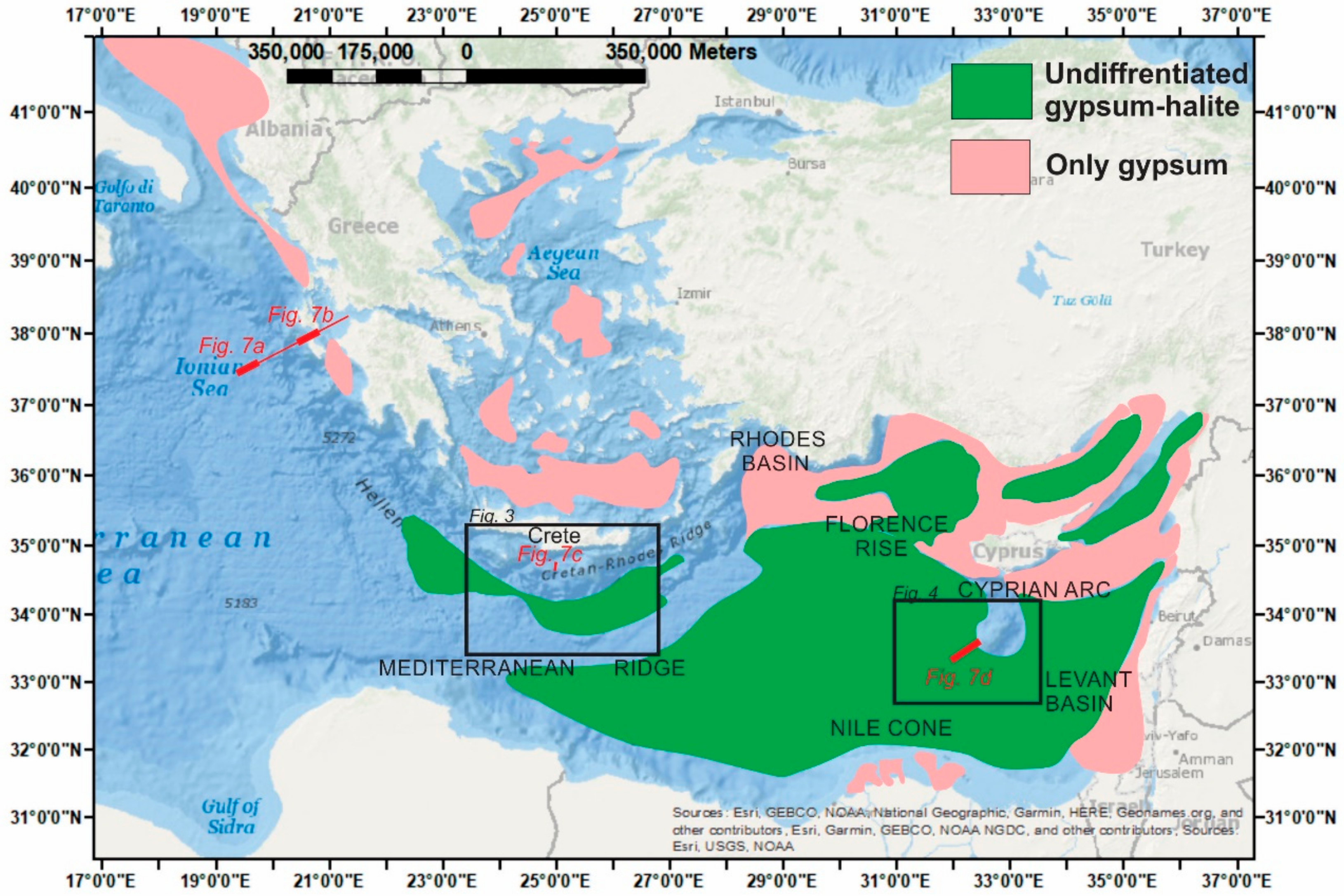

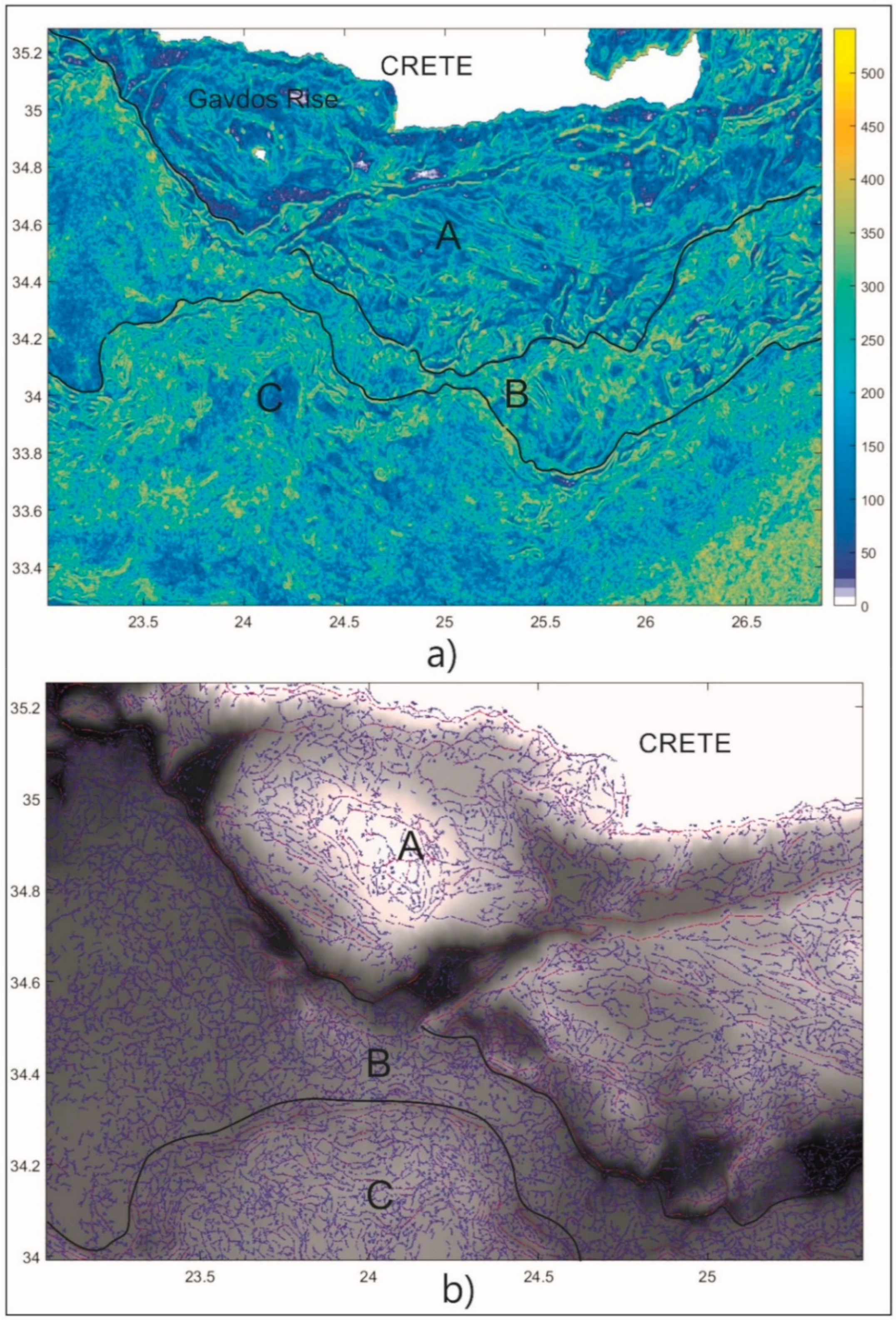
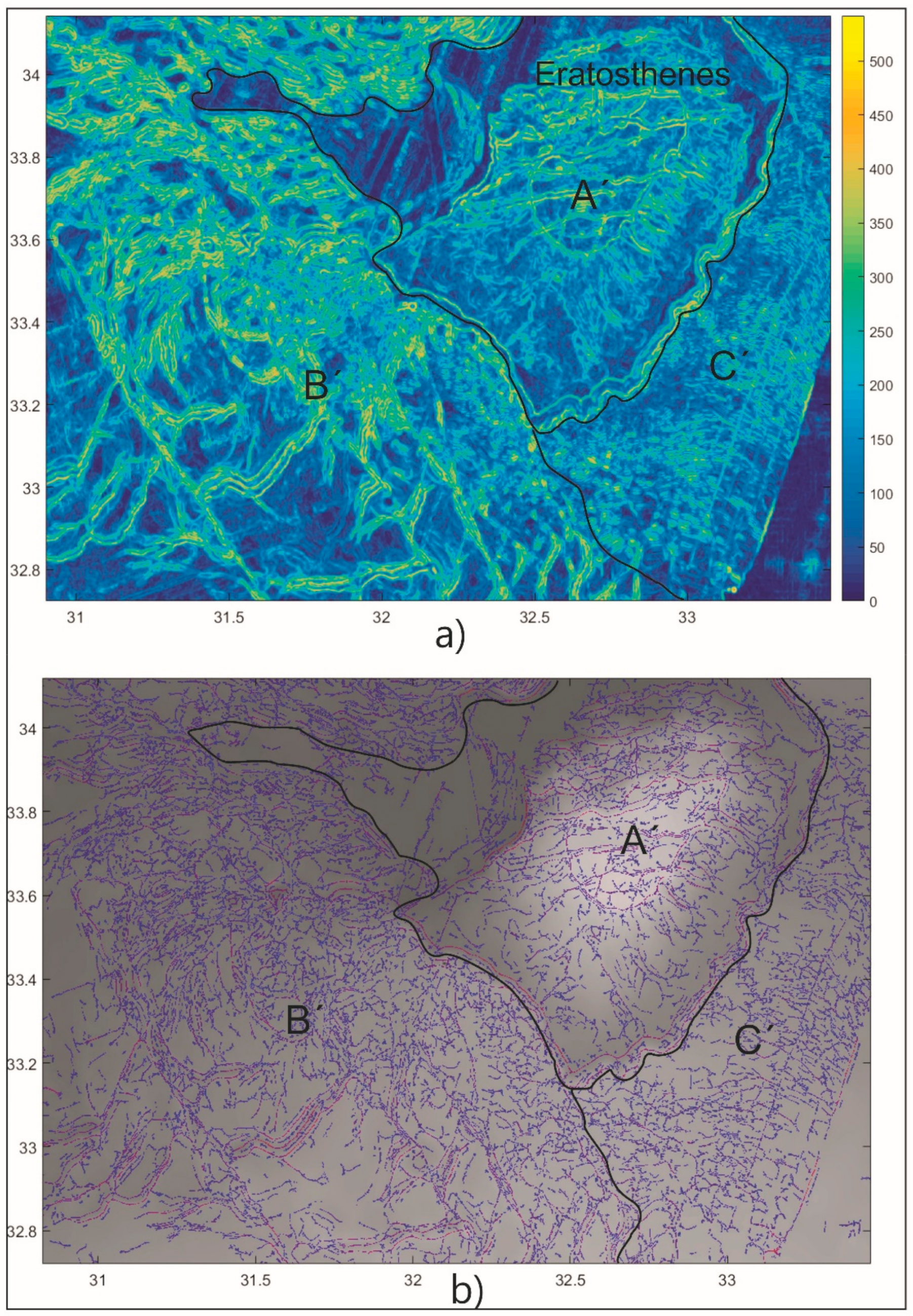
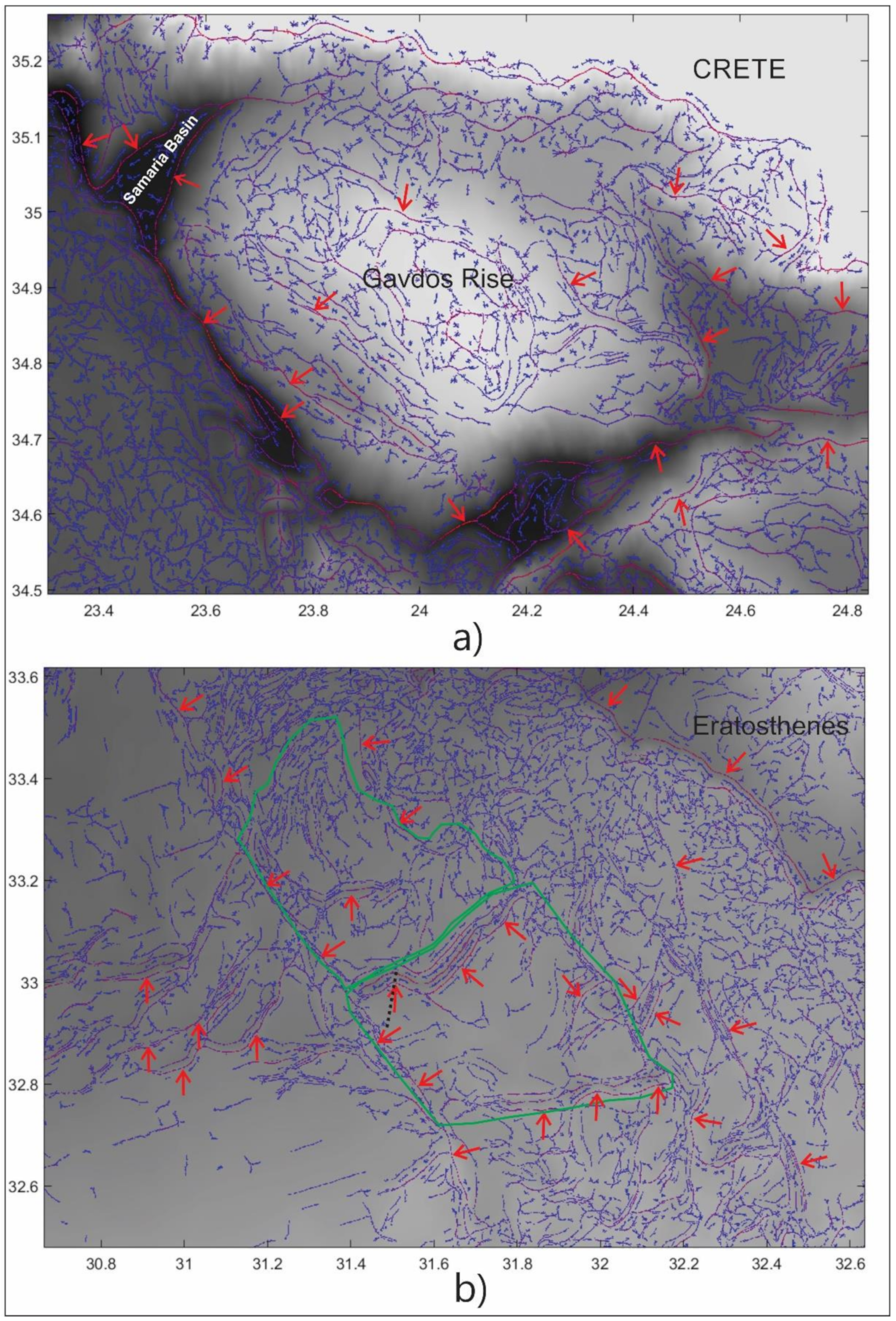

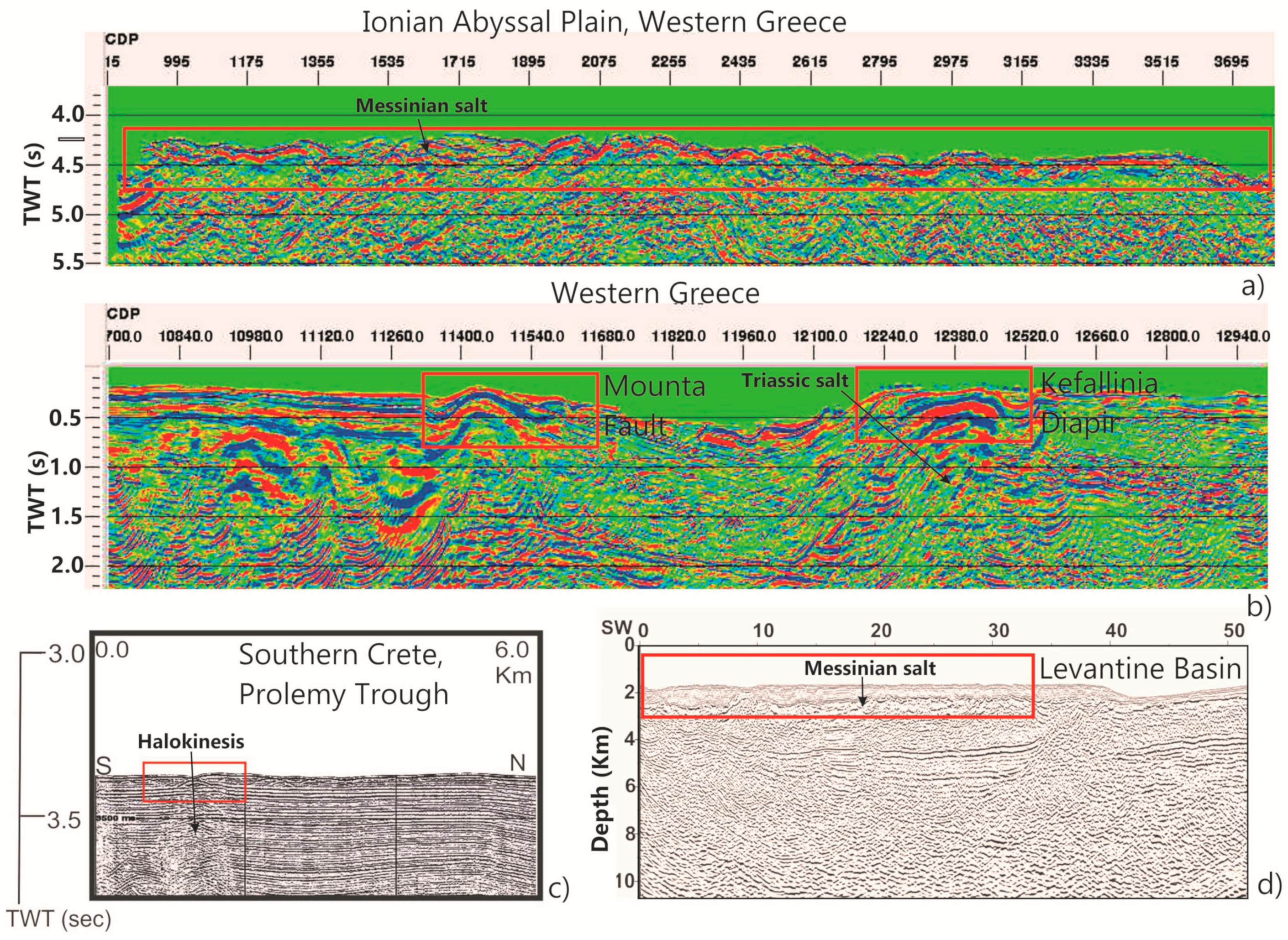
© 2020 by the authors. Licensee MDPI, Basel, Switzerland. This article is an open access article distributed under the terms and conditions of the Creative Commons Attribution (CC BY) license (http://creativecommons.org/licenses/by/4.0/).
Share and Cite
Kokinou, E.; Panagiotakis, C. Automatic Pattern Recognition of Tectonic Lineaments in Seafloor Morphology to Contribute in the Structural Analysis of Potentially Hydrocarbon-Rich Areas. Remote Sens. 2020, 12, 1538. https://doi.org/10.3390/rs12101538
Kokinou E, Panagiotakis C. Automatic Pattern Recognition of Tectonic Lineaments in Seafloor Morphology to Contribute in the Structural Analysis of Potentially Hydrocarbon-Rich Areas. Remote Sensing. 2020; 12(10):1538. https://doi.org/10.3390/rs12101538
Chicago/Turabian StyleKokinou, Eleni, and Costas Panagiotakis. 2020. "Automatic Pattern Recognition of Tectonic Lineaments in Seafloor Morphology to Contribute in the Structural Analysis of Potentially Hydrocarbon-Rich Areas" Remote Sensing 12, no. 10: 1538. https://doi.org/10.3390/rs12101538
APA StyleKokinou, E., & Panagiotakis, C. (2020). Automatic Pattern Recognition of Tectonic Lineaments in Seafloor Morphology to Contribute in the Structural Analysis of Potentially Hydrocarbon-Rich Areas. Remote Sensing, 12(10), 1538. https://doi.org/10.3390/rs12101538






